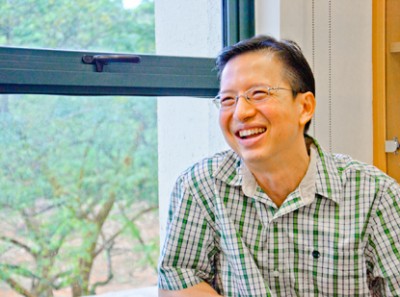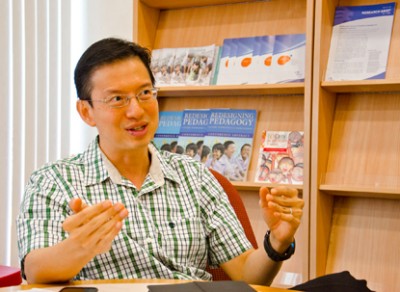Why Singapore’s English Teachers Should Embrace Singlish, Not Fight It
Is it time for Singaporean educators to embrace Singlish as a legitimate learning tool? What the Research […]
Read More
Special needs used to be something new and foreign to teachers. But Singapore schools and teachers have made big strides in providing support for students with special needs in recent years.
Dr Kenneth Poon worked with children with disabilities for several years before he left for his doctoral studies in the US. When he returned in 2005, he was met with a field that looked quite different.
 A recent turning point in special education (SPED), Kenneth says, came in 2004. That was when Prime Minister Lee Hsien Loong outlined his vision of Singapore as an inclusive society.
A recent turning point in special education (SPED), Kenneth says, came in 2004. That was when Prime Minister Lee Hsien Loong outlined his vision of Singapore as an inclusive society.
“Every society has some members with disabilities. How the society treats the disabled, takes care of them, and helps them integrate into the mainstream, reflects the kind of society it is. We want ours to be a society that cares for all its members; one that does not ignore the needs of those who are born or afflicted with disabilities.” (Lee, 2004)
PM Lee’s call heralded the accelerated transformation of special needs services. One significant development was the increased support for students with special needs in mainstream schools.
“There is recognition now that children with special needs do exist in mainstream school settings,” explains Kenneth. “They’ve always been there. What we’re trying to do now is to see how we can better support them.”
To that end, a percentage of teachers are now trained to support such students. All primary and some secondary schools also have an Allied Educator specially trained to look after the learning and behavioural needs of these students.
In the past, the focus was on supporting students with physical or sensory impairments.
“Now, it’s to see how we can further support those who have impairments that we do not see,” says Kenneth. These include conditions such as dyslexia, attention deficit hyperactivity disorder (ADHD), or autism spectrum disorder (ASD).
There is recognition now that children with special needs do exist in mainstream school settings.
– Kenneth Poon, Centre for Research in Pedagogy and Practice
“There are many children who in the past would be called ‘stupid’, ‘lazy’, or ‘unmotivated’. Now we understand why many of these children were previously unmotivated to learn. Sometimes, it’s because they cannot access the learning.”
Depending on how the disorders are defined, students with special needs may comprise 5–15% of a cohort. But they’re not as different from other students as you might think.
“It’s important to understand that special needs are part of the broader variation of human characteristics,” adds Kenneth. “Many students might show some of these characteristics and it’s OK! It’s human variability.”
But when your students experience difficulties that interfere with their learning, behaviour or social interactions in school, it warrants a closer look.
Teachers are the best persons to identify which students are not doing well because of such conditions, and they’re usually very good at it, says Kenneth.
“Fresh teachers might take a while but experienced teachers, they don’t need more than 2 weeks to know very clearly who are the ones that stand out in the class!”
However, he appeals to teachers to exercise care in such assessments. Terms such as ADHD or ASD can serve as shorthand for students’ learning needs. But such labels can be hurtful to the children and their parents if used carelessly.
“What teachers very frequently mean when they use such terms is: ‘Well, this child could be very active. This child is not staying at his seat. This child has difficulties getting along with other students in the class.’”
Instead of using such labels, teachers could describe the child’s behaviour.
“It helps for teachers to be descriptive of how the child is having difficulty,” Kenneth advises, “because teachers provide a lot of valuable information which parents and other professionals cannot observe in school.”
 Once a child has been identified as having special needs, how can teachers support them in the classroom?
Once a child has been identified as having special needs, how can teachers support them in the classroom?
There’s no need for drastic changes, says Kenneth. The first thing teachers can do is to be understanding. “It does require the patience of teachers who already have a very full plate.”
The second thing they can do is to find out more about their students’ condition. This will help them to customize their teaching and the curriculum, if necessary.
Thirdly, they can consider how the classroom is configured physically. They can also rally the class to be supportive of those who are different from them. In this way, a positive climate can be created in the classroom for all.
Last, but certainly not least, teachers can look to the child’s parents for help. They know their child best. “Very frequently, the parents have a lot of good ideas,” Kenneth notes.
Teachers will find that such measures usually benefit the whole class. “A lot of what supports the child with special needs will support most of the students in the classroom.”
Kenneth recalls the time when he first started training teachers, and “special needs was something very new to them”.
Things are very different now. “Many teachers, from primary schools especially, now come in with stories about how their schools are supporting students with special needs,” he observes.
– Kenneth on how inclusion helps everyone in the classroom
“It’s no longer us as teacher educators introducing something new to them,” he adds. “It’s reached this point where I’m able to facilitate their learning simply by helping schools to learn from what each other is doing.”
The next lap, says Kenneth, is to answer the question of how well we are supporting students with special needs.
“What are the best conditions in which we can support these students? So it’s the question of quality, the question of outcomes, the question of what are the factors that bring more positive outcomes among our children with disabilities.”
These are important questions as we try to create the best environment for students with special needs to learn and grow in. After all, the development of an inclusive society, as envisioned by PM Lee, should begin in school.
Reference
Lee, H. L. (2004, September 18). Speech by Prime Minister Lee Hsien Loong at the opening of the Spastic Children’s Association of Singapore’s Cerebral Palsy Centre. Retrieved from National Archives of Singapore website: https://a2o.nas.sg/stars
Useful Resources
Poon, K. K. (2012). The education of children with special needs: History, trends and future directions. In J. Tan (Ed.), Education in Singapore: Taking stock, looking forward (pp. 101–111). Singapore: Pearson.
Poon, K. K., Musti-Rao, S., & Wettasinghe, C. M. (2013). Special education in Singapore: History, trends, and future directions. Intervention in School and Clinic, 47, 1–18. doi: 10.1177/1053451212472230